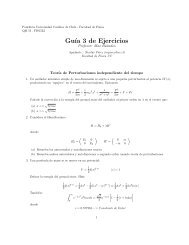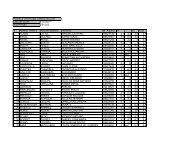- Page 2 and 3: Pontificia Universidad Católica de
- Page 5: Pero, como sabemos que σ 2 y = 1 y
- Page 9 and 10: Pontificia Universidad Católica de
- Page 11 and 12: Entonces, se obtiene:Lo que se tran
- Page 13 and 14: o también:(Ψ(t) = e −iE( 0)t/ 1
- Page 15 and 16: al resultado general y formamos un
- Page 17 and 18: SolucionesProblema 1:El hamiltonian
- Page 19 and 20: |S 2y = /2〉 = 1 √2(| ↑〉 2 +
- Page 21 and 22: Pontificia Universidad Católica de
- Page 23 and 24: Problema 1:SolucionesConsideremos l
- Page 25 and 26: 〈l|a 3 a † |0〉 = 〈l|a 3 |1
- Page 27 and 28: Como hemos notado, obtenemos el mis
- Page 29 and 30: Problemas ExtraDerive en detalle la
- Page 31 and 32: Pontificia Universidad Católica de
- Page 33 and 34: donde hemos introducido el parámet
- Page 35 and 36: ⎞Entonces, tenemos dos matrices i
- Page 37 and 38: Pontificia Universidad Católica de
- Page 39 and 40: Problema 1:SolucionesPara resolver
- Page 41 and 42: I 2 =Ahora, podemos calcular I = (I
- Page 43 and 44: Mientras que con el valor original
- Page 45 and 46: Ahora, necesitamos obtener la corre
- Page 47 and 48: V =⎛⎜⎝0 〈2s|V |2p, m = 0〉
- Page 49 and 50: Entonces, nuestro problema se reduc
- Page 51 and 52: 3. Un cierto sistema cuántico se e
- Page 53 and 54: V ij = 〈φ i |V |φ j 〉〈1, 0|
- Page 55 and 56: En el caso de b 3 se tiene:ḃ 2 =
- Page 57 and 58:
〈D z (t)〉 = b ∗ 1(t)b 2 (t)e
- Page 59 and 60:
Problema 1:SolucionesPara resolver
- Page 61 and 62:
La energía que aparece en el denom
- Page 63 and 64:
Pontificia Universidad Católica de
- Page 65 and 66:
Problema 1:SolucionesSe tiene un po
- Page 67 and 68:
Luego, obtenemos:ρ(E k ) =dΓ =dΓ
- Page 69 and 70:
a + b ===11/a 0 − ik − 11/a 0 +
- Page 71 and 72:
Ahora, esto puede ser transformado,
- Page 73 and 74:
Así que tenemos:〈nljm|H K |nljm
- Page 75 and 76:
y definiendo:ɛ ′ = ɛ − E nl(Z
- Page 77 and 78:
Problema 3 - Átomo de Hidrógeno:C
- Page 79 and 80:
Con esto, lo que se tiene según lo
- Page 81 and 82:
= 1.055 × 10 −30 kgcm 2 /sc = 3
- Page 83 and 84:
Relacion de recursion : H n+1 (αx)
- Page 85 and 86:
que corresponde a lo pedido.(b) Ten
- Page 87 and 88:
ω fi = E 1 − E 0√kω =m(562)(5
- Page 89 and 90:
Pontificia Universidad Católica de
- Page 91 and 92:
Luego, recordemos como se resuelve
- Page 93 and 94:
e ⃗ S 2 | + −〉 = e ⃗ S 2 1
- Page 95 and 96:
Pontificia Universidad Católica de
- Page 97 and 98:
SolucionesProblema 1:(a) De clases,
- Page 99 and 100:
De modo que evaluando en los ángul
- Page 101 and 102:
Pontificia Universidad Católica de
- Page 103 and 104:
2 Aproximación WKB2.1 Problemas Re
- Page 105 and 106:
E = 1 ( ( 22 mω2 n + 1 ) )− b 2m
- Page 107 and 108:
[ √ ]1/6 2/6B = √2/6 1/3(675)Es
- Page 109 and 110:
Ahora el elemento de matriz se calc
- Page 111 and 112:
De modo que nos es posible escribir
- Page 113 and 114:
( ) 2πc2 1/2⃗A ⃗k, ⃗ λ|N k1
- Page 115 and 116:
Podemos hacer una analogía con la
- Page 117 and 118:
Queda demostrado.b) Queremos demost
- Page 119 and 120:
Como el operador involucrado consis
- Page 121 and 122:
Esto se simplifica , eliminando té
- Page 123 and 124:
considerando:k =√2mE 2 y E n = 2
- Page 125 and 126:
y, entonces:P † (12) = P (12)esto
- Page 127 and 128:
a) Una posible solución al problem
- Page 129 and 130:
De modo que tenemos tres casos:| 1,





